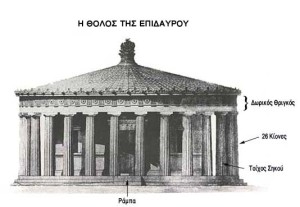Public Procurement in Greek Antiquity
As informed by Prof. Theodosios P. Tassios of the National Polytechnic School, the concepts of Contract Notice, Technical Specifications, Contractor Selection, Supervision, Payments and Financial Accounting are first traced in the democratic ancient cities (but not the oligarchic), which financed projects and assigned the technical and financial management of public works to the jurisdiction of the Parliament, which designated "lords" (as Authorities) to monitor works, who were accountable only to the Parliament.
A significant number of details of ancient inscriptions, engraved in stone, which are kept in various Museums of the country, give us important information on public works in the antiquity. These inscriptions contain project descriptions, technical parts, construction instructions for the source of materials and how to process and integrate them, names of project agents, unit prices, penalties for delinquency or mismanagement, as well as detailed accounts of amounts received and spent, while these columns were properly publicized, at appropriate points in the City, that is, in public view engraved on marble slabs (as other Government’s Gazette or KIMDIS) and from this point they could not be forged.
Filon’s Arsenal & Other Projects
The logo of HSPPA depicts an important public work of that time, which was constructed based on a public contract. It was the well-known Arsenal of Filon (Port of Zea, 347 BC), which was engraved in column EM12538 (Athens Epigraphy Museum), with many technical details and dimensions, that allowed modern archaeologists to fully design it even before its foundations were excavated (in 1988). This massive building was intended for the maintenance of the equipment of “trieres” were discovered (the archaeological site can be found at 170 Ipsilantou Str., in Pireaus).

Archaeologist Mr. M. Vlamos informs us that the agreement between the State (contracting authority) and engineer Filon (contractor) also included instructions for ventilation of the interior of the building in order to properly preserve the stored wooden elements.
In these public works, the Designer had the right to complete the Design during the construction or to display a model, the so-called "example".
A very interesting point is how the Contractors were selected. Initially, the Design and the Specifications were made public and then contractors and skilled craftsmen were invited, albeit from other Cities, in which case their travel expenses were covered, regardless of the final selection. The average remuneration amounted to 14 "ergones", as mentioned e.g. in a related column (Archaeological Museum of Epidaurus) describing the construction of the Epidaurus Dome (l. 50-55). However, each "ergon" had a local "guarantor" (a citizen of the city where the public work was constructed) for its payment, while in the case of more important contracts, the "guarantors" were significantly more.
An important project and contract, with many “guarantors”, was the case of the drainage of Lake of Ptechon in Euboea (the world's first project “Build, Operate and Transfer”, paid for by a 10-year concession to the Contractor Chairefani and his Consortium, in the 4th Century BC), while in the said project they even came to impose the minimum compensatory benefit that should be provided to the surrounding farmers in the course of the works.
Also, in the case of the Reitos Bridge (Skaramangas, Attica), column 5093 of the Elefsina Archaeological Museum describes the exact origin of the stones, as well as the type of hammers that would be used during assembly so as not to damage the stones.
All payments were recorded separately in the columns of the financial report, which were executed by "Logiste" (accountants) - or "Apologoi", etc. - designated by the Parliament, each month, while in Athens the financial reports engraved on the plates were "wall-hung" on the works - judging from the accounts of the Erechtheion of Athens.

These were, in short, a few words regarding public works in ancient Greece, with the largest being the construction of the Acropolis, where in the end both Pericles and Phidias were criminally charged.
Public works and their historical route, from antiquity to Roman, Byzantine, Ottoman times and to the modern years until today, is an important chapter in human history that is worth studying.

The public contract of Filon’s Arsenal



